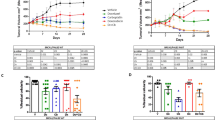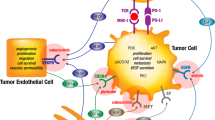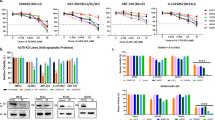Abstract
A doxorubicin-resistant line of B16 melanoma (B16VDXR) was obtained in vitro by continuous exposure to increasing concentrations of doxorubicin of an in vitro line (B16V) derived from the in vivo transplanted B16 melanoma. When injected s.c. into mice, B16VDXR exhibited histological features, metastatic behaviour, doubling time and tumourigenic potential similar to those of the parental B16V line. Tumours obtained by implantation of B16VDXR, however, had longer latency and permitted a longer survival time than B16V and had, as in vitro, a higher DNA content. After i.v. inoculation, B16VDXR cells had lower lung colonizing capability compared to B16V. B16V and B16VDXR had significantly lower metastatic potential compared to the B16 melanoma from which they derived. Doxorubicin treatment significantly delayed the growth of B16 and B16V transplanted s.c. and increased the life span of animals bearing B16V. B16VDXR was resistant to doxorubicin treatment when the in vitro resistance index was greater than 100. While the doxorubicin-resistance phenotype was stable in vitro for 50 passages, in vivo the resistance phenotype was lost in 5 passages and tumours grown from s.c. inocula of mixtures of similar percentages of sensitive and resistant cells behaved as sensitive tumours. Cis-diamminedichloroplatinum (II), although marginally active in animals bearing B16V, was highly effective in B16VDXR bearing animals, suggesting a collateral cis-diamminedichloroplatinum (II) sensitivity of the B16VDXR line. After a single i.v. administration, doxorubicin reached initially, in the B16VDXR line, levels similar to those found in the B16 and B16V lines, but its release was faster from the resistant line in comparison with the sensitive ones. Doxorubicin-resistance was not overcome by more frequent treatments with doxorubicin. This doxorubicin-resistant tumour line obtained in vitro and used as a first in vivo transplant, may be a suitable metastaizing model for in vivo study of the mechanisms of resistance and of collateral sensitivity and for screening new drugs.
This is a preview of subscription content, access via your institution
Access options
Subscribe to this journal
Receive 24 print issues and online access
$259.00 per year
only $10.79 per issue
Buy this article
- Purchase on Springer Link
- Instant access to full article PDF
Prices may be subject to local taxes which are calculated during checkout
Similar content being viewed by others
Rights and permissions
About this article
Cite this article
Formelli, F., Rossi, C., Supino, R. et al. In vivo characterization of a doxorubicin resistant B16 melanoma cell line. Br J Cancer 54, 223–233 (1986). https://doi.org/10.1038/bjc.1986.166
Issue Date:
DOI: https://doi.org/10.1038/bjc.1986.166
This article is cited by
-
Down-regulation of MFG-E8 by RNA interference combined with doxorubicin triggers melanoma destruction
Clinical and Experimental Medicine (2015)
-
Drug rechallenge and treatment beyond progression—implications for drug resistance
Nature Reviews Clinical Oncology (2013)
-
Vascular density and endothelial cell expression of integrin alpha v beta 3 and E-selectin in murine tumours
Tumor Biology (2012)
-
Mouse tumors are heterogeneous in their susceptibility to syngeneic lymphokine-activated killer cells and delineate functional subsets in such effectors
Cancer Immunology Immunotherapy (1990)



